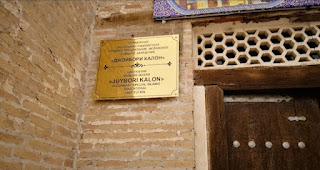10.11.23 Emir's Palace in Kagan

Today we went to one of the nost outstanding places of Bukhara. It was Emirs Palace in Kagan The palace’s origins lie in the expansion of the Russian Empire to Central Asia in the second half of the 19th century. Towards the end of the century, strong diplomatic relations developed between Russia and the Bukhara Emirate, and the development of railways continued. The settlement of New Bukhara was established 12km from Bukhara, on the railway line to Tashkent, and New Bukhara became a base for the Russian military, engineers, and builders. In a sense, New Bukhara was also a diplomatic town, which hosted various offices that represented the Russian Empire in the Emirate of Bukhara. In 1895, the Emir of Bukhara, Said Abdulahad Khan, ordered the construction of a palace in New Bukhara. According to some, this was because the Emir wanted to have his own palace in the Russian settlement. In another version of the story, the palace was built to accommodate a visit by the Russian Emperor,...





